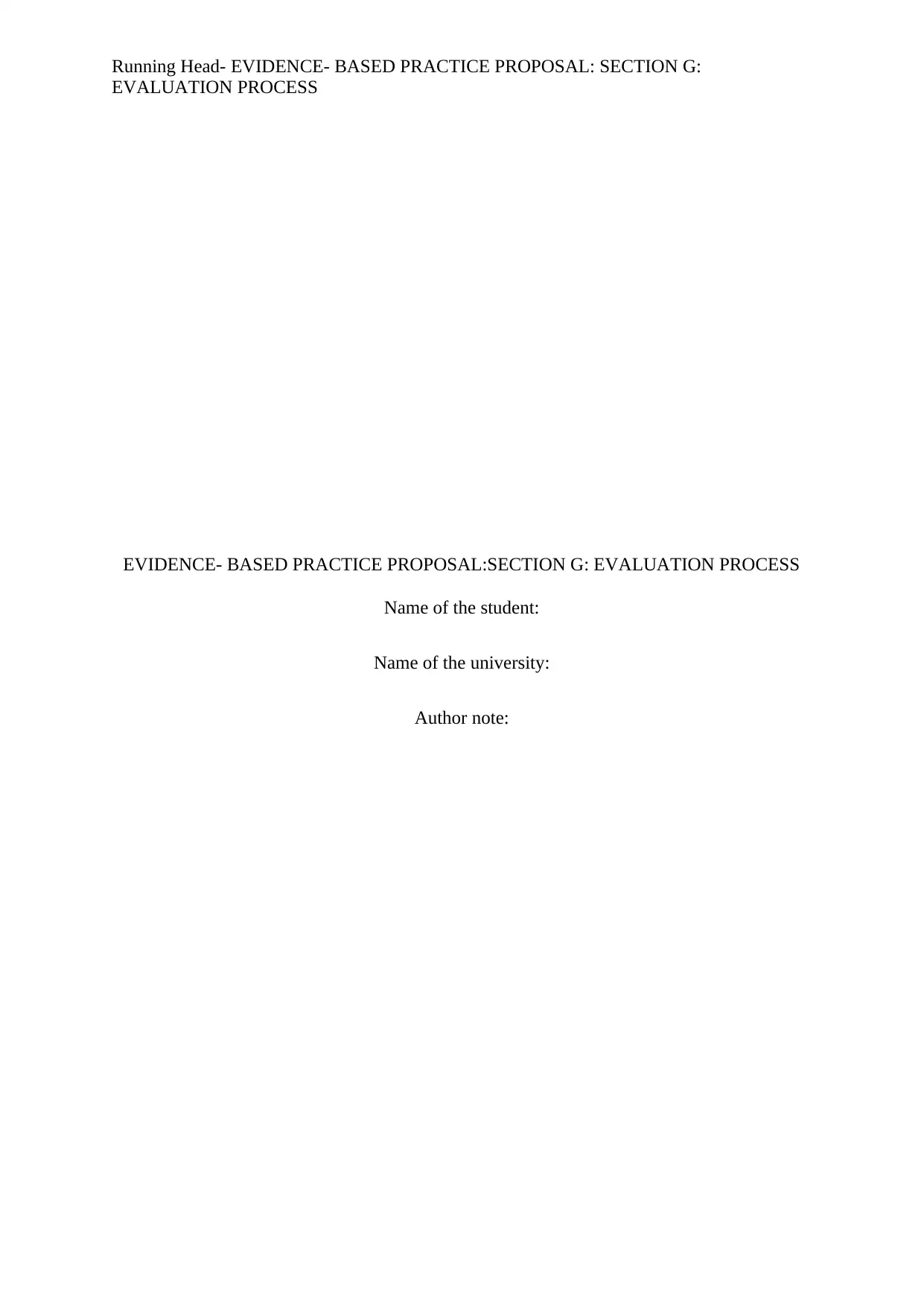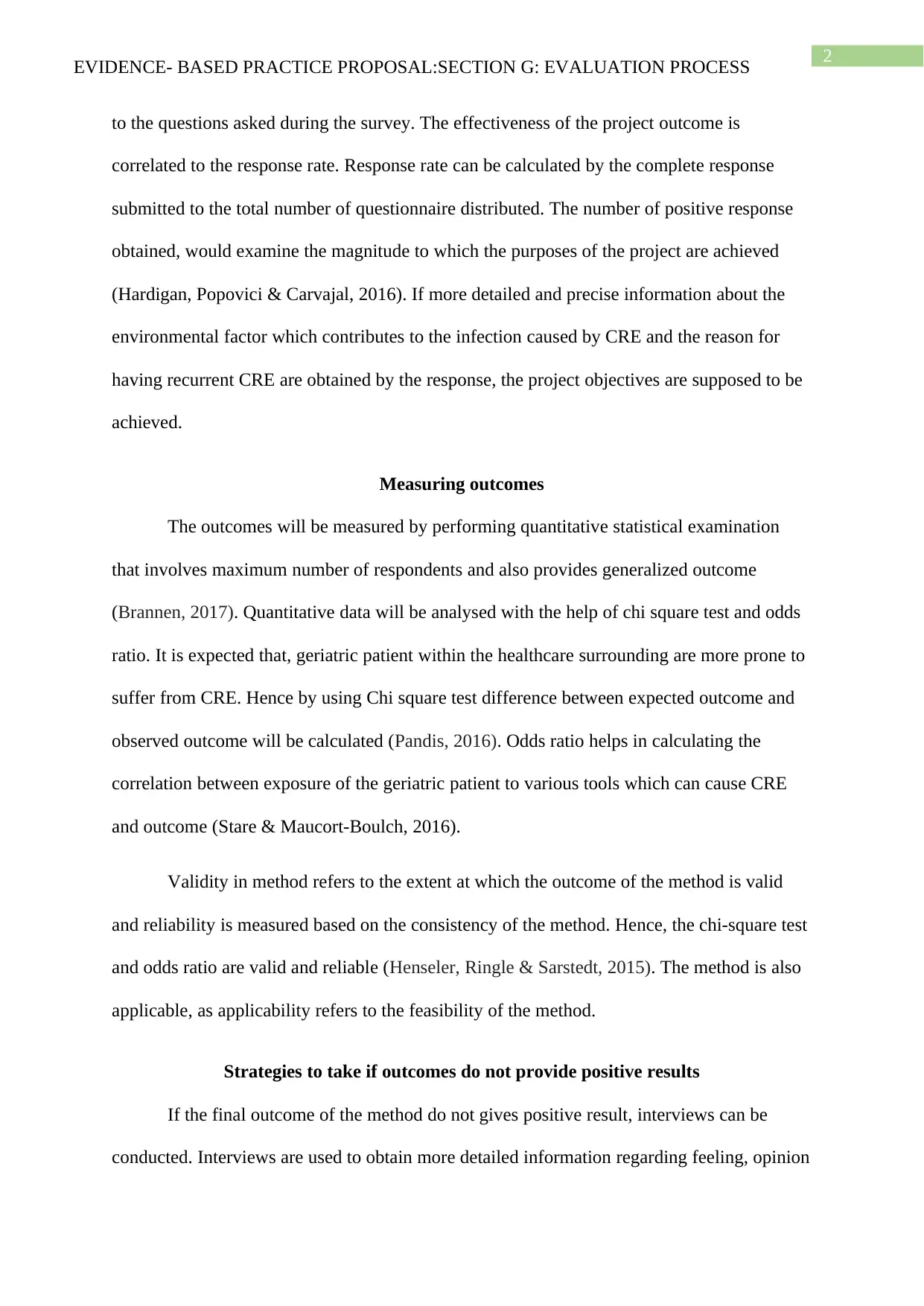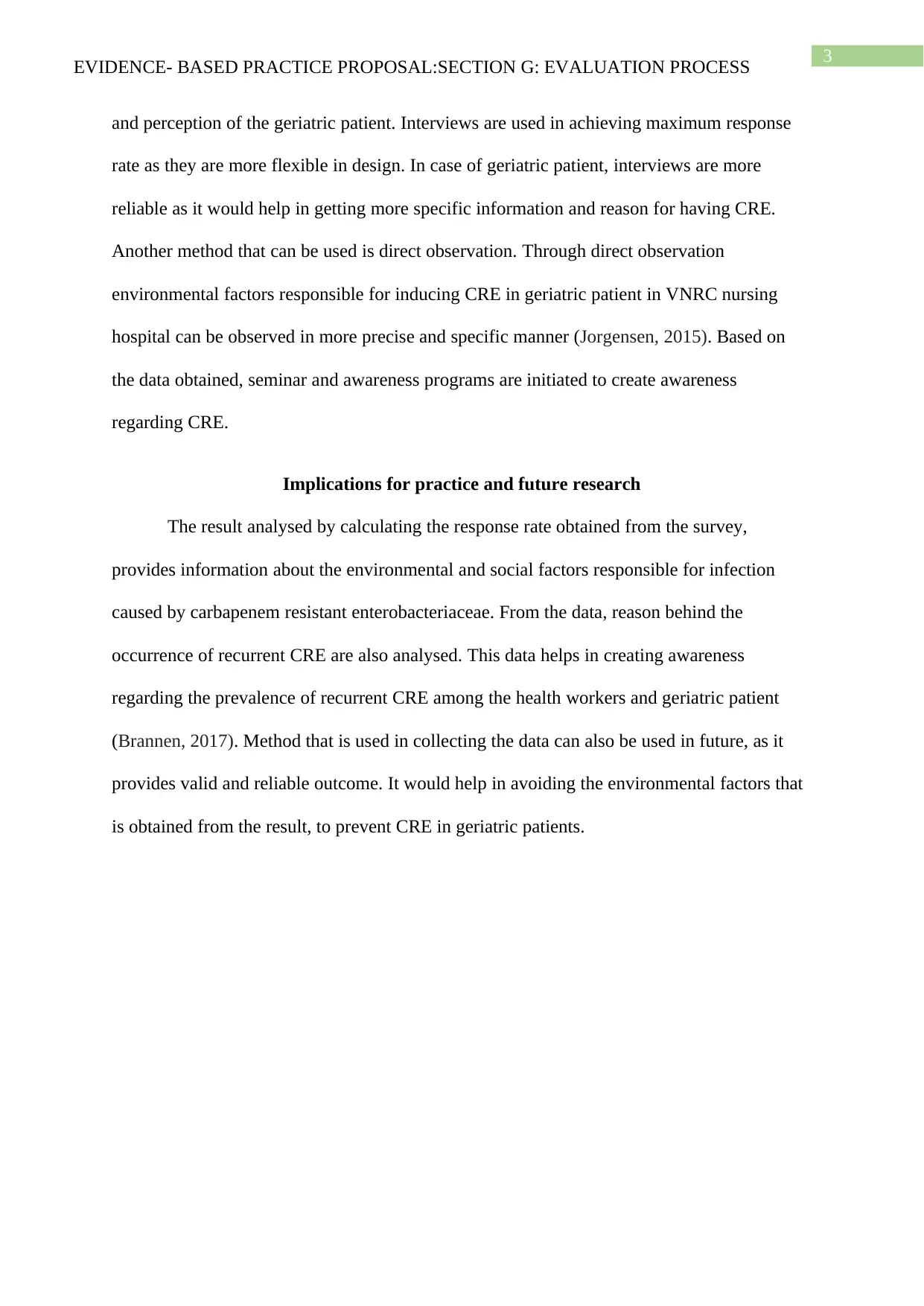Grand Canyon University: NUR 699 - CRE Infection Evaluation Process
VerifiedAdded on 2023/04/23
|6
|1290
|391
Report
AI Summary
This report details the evaluation process for Carbapenem-resistant Enterobacteriaceae (CRE) infections, particularly in geriatric patients within healthcare settings. The study employs surveys as the primary data collection method, emphasizing their representativeness and cost-effectiveness. The evaluation utilizes chi-square tests and odds ratios to analyze quantitative data, aiming to determine the prevalence of CRE and the effectiveness of awareness programs. The report outlines strategies to be implemented if outcomes do not provide positive results, such as interviews and direct observations, to gather more in-depth information. Furthermore, the report discusses the implications of the findings for practice and future research, highlighting the importance of the data in creating awareness and preventing the spread of CRE. References are included to support the research and methodologies used in the report.

Running Head- EVIDENCE- BASED PRACTICE PROPOSAL: SECTION G:
EVALUATION PROCESS
EVIDENCE- BASED PRACTICE PROPOSAL:SECTION G: EVALUATION PROCESS
Name of the student:
Name of the university:
Author note:
EVALUATION PROCESS
EVIDENCE- BASED PRACTICE PROPOSAL:SECTION G: EVALUATION PROCESS
Name of the student:
Name of the university:
Author note:
Paraphrase This Document
Need a fresh take? Get an instant paraphrase of this document with our AI Paraphraser

1
EVIDENCE- BASED PRACTICE PROPOSAL:SECTION G: EVALUATION PROCESS
Introduction
Carbapenem-resistant Enterobacteriaceae infection is a bacterial infection caused by
bacteria of Enterobacteriaceae family, which is resistant to an effective antibiotic,
carbapenem. Patients in nursing hospitals are more prone to have CRE, especially geriatric
patient (McConville, Sullivan, Gomez-Simmonds, Whittier & Uhlemann, 2017). To examine
the prevalence of CRE in geriatric patients, survey is conducted. Surveys are valid, reliable
and applicable. To analyse the quantitative data obtained from the survey, chi square test and
odds ratio is used. Interviews and direct observation would be done, if the outcome do not
provide positive result which are implemented in practice for future research.
Rationale for the methods used in collecting the outcome data
It is observed that people within the health care setting are more susceptible to CRE.
To measure the effectiveness of the seminar and hand-on-workshop done to create awareness
regarding CRE, survey would be conducted. Surveys are one of the best method of collecting
data. They are highly representative, issue of large population can be represented. Cost of
conducting survey is also very less which makes it one of the reliable method. With the help
of survey data can be gathered conveniently as well as it also provides statistical significance
of high quality (Moser & Kalton, 2017). By conducting survey among the geriatric patient,
precise result would be obtained as biases would be abolished. The question of the survey
would be designed based on the condition responsible for CRE. It makes it more flexible and
standard.
Ways in which the outcome measures evaluate the extent to which the project objectives
are achieved
The process used in gathering the final data are surveys. Effectiveness of the surveys
is calculated by help of response rate. Response rate is the number of respondents answered
EVIDENCE- BASED PRACTICE PROPOSAL:SECTION G: EVALUATION PROCESS
Introduction
Carbapenem-resistant Enterobacteriaceae infection is a bacterial infection caused by
bacteria of Enterobacteriaceae family, which is resistant to an effective antibiotic,
carbapenem. Patients in nursing hospitals are more prone to have CRE, especially geriatric
patient (McConville, Sullivan, Gomez-Simmonds, Whittier & Uhlemann, 2017). To examine
the prevalence of CRE in geriatric patients, survey is conducted. Surveys are valid, reliable
and applicable. To analyse the quantitative data obtained from the survey, chi square test and
odds ratio is used. Interviews and direct observation would be done, if the outcome do not
provide positive result which are implemented in practice for future research.
Rationale for the methods used in collecting the outcome data
It is observed that people within the health care setting are more susceptible to CRE.
To measure the effectiveness of the seminar and hand-on-workshop done to create awareness
regarding CRE, survey would be conducted. Surveys are one of the best method of collecting
data. They are highly representative, issue of large population can be represented. Cost of
conducting survey is also very less which makes it one of the reliable method. With the help
of survey data can be gathered conveniently as well as it also provides statistical significance
of high quality (Moser & Kalton, 2017). By conducting survey among the geriatric patient,
precise result would be obtained as biases would be abolished. The question of the survey
would be designed based on the condition responsible for CRE. It makes it more flexible and
standard.
Ways in which the outcome measures evaluate the extent to which the project objectives
are achieved
The process used in gathering the final data are surveys. Effectiveness of the surveys
is calculated by help of response rate. Response rate is the number of respondents answered

2
EVIDENCE- BASED PRACTICE PROPOSAL:SECTION G: EVALUATION PROCESS
to the questions asked during the survey. The effectiveness of the project outcome is
correlated to the response rate. Response rate can be calculated by the complete response
submitted to the total number of questionnaire distributed. The number of positive response
obtained, would examine the magnitude to which the purposes of the project are achieved
(Hardigan, Popovici & Carvajal, 2016). If more detailed and precise information about the
environmental factor which contributes to the infection caused by CRE and the reason for
having recurrent CRE are obtained by the response, the project objectives are supposed to be
achieved.
Measuring outcomes
The outcomes will be measured by performing quantitative statistical examination
that involves maximum number of respondents and also provides generalized outcome
(Brannen, 2017). Quantitative data will be analysed with the help of chi square test and odds
ratio. It is expected that, geriatric patient within the healthcare surrounding are more prone to
suffer from CRE. Hence by using Chi square test difference between expected outcome and
observed outcome will be calculated (Pandis, 2016). Odds ratio helps in calculating the
correlation between exposure of the geriatric patient to various tools which can cause CRE
and outcome (Stare & Maucort-Boulch, 2016).
Validity in method refers to the extent at which the outcome of the method is valid
and reliability is measured based on the consistency of the method. Hence, the chi-square test
and odds ratio are valid and reliable (Henseler, Ringle & Sarstedt, 2015). The method is also
applicable, as applicability refers to the feasibility of the method.
Strategies to take if outcomes do not provide positive results
If the final outcome of the method do not gives positive result, interviews can be
conducted. Interviews are used to obtain more detailed information regarding feeling, opinion
EVIDENCE- BASED PRACTICE PROPOSAL:SECTION G: EVALUATION PROCESS
to the questions asked during the survey. The effectiveness of the project outcome is
correlated to the response rate. Response rate can be calculated by the complete response
submitted to the total number of questionnaire distributed. The number of positive response
obtained, would examine the magnitude to which the purposes of the project are achieved
(Hardigan, Popovici & Carvajal, 2016). If more detailed and precise information about the
environmental factor which contributes to the infection caused by CRE and the reason for
having recurrent CRE are obtained by the response, the project objectives are supposed to be
achieved.
Measuring outcomes
The outcomes will be measured by performing quantitative statistical examination
that involves maximum number of respondents and also provides generalized outcome
(Brannen, 2017). Quantitative data will be analysed with the help of chi square test and odds
ratio. It is expected that, geriatric patient within the healthcare surrounding are more prone to
suffer from CRE. Hence by using Chi square test difference between expected outcome and
observed outcome will be calculated (Pandis, 2016). Odds ratio helps in calculating the
correlation between exposure of the geriatric patient to various tools which can cause CRE
and outcome (Stare & Maucort-Boulch, 2016).
Validity in method refers to the extent at which the outcome of the method is valid
and reliability is measured based on the consistency of the method. Hence, the chi-square test
and odds ratio are valid and reliable (Henseler, Ringle & Sarstedt, 2015). The method is also
applicable, as applicability refers to the feasibility of the method.
Strategies to take if outcomes do not provide positive results
If the final outcome of the method do not gives positive result, interviews can be
conducted. Interviews are used to obtain more detailed information regarding feeling, opinion
⊘ This is a preview!⊘
Do you want full access?
Subscribe today to unlock all pages.

Trusted by 1+ million students worldwide

3
EVIDENCE- BASED PRACTICE PROPOSAL:SECTION G: EVALUATION PROCESS
and perception of the geriatric patient. Interviews are used in achieving maximum response
rate as they are more flexible in design. In case of geriatric patient, interviews are more
reliable as it would help in getting more specific information and reason for having CRE.
Another method that can be used is direct observation. Through direct observation
environmental factors responsible for inducing CRE in geriatric patient in VNRC nursing
hospital can be observed in more precise and specific manner (Jorgensen, 2015). Based on
the data obtained, seminar and awareness programs are initiated to create awareness
regarding CRE.
Implications for practice and future research
The result analysed by calculating the response rate obtained from the survey,
provides information about the environmental and social factors responsible for infection
caused by carbapenem resistant enterobacteriaceae. From the data, reason behind the
occurrence of recurrent CRE are also analysed. This data helps in creating awareness
regarding the prevalence of recurrent CRE among the health workers and geriatric patient
(Brannen, 2017). Method that is used in collecting the data can also be used in future, as it
provides valid and reliable outcome. It would help in avoiding the environmental factors that
is obtained from the result, to prevent CRE in geriatric patients.
EVIDENCE- BASED PRACTICE PROPOSAL:SECTION G: EVALUATION PROCESS
and perception of the geriatric patient. Interviews are used in achieving maximum response
rate as they are more flexible in design. In case of geriatric patient, interviews are more
reliable as it would help in getting more specific information and reason for having CRE.
Another method that can be used is direct observation. Through direct observation
environmental factors responsible for inducing CRE in geriatric patient in VNRC nursing
hospital can be observed in more precise and specific manner (Jorgensen, 2015). Based on
the data obtained, seminar and awareness programs are initiated to create awareness
regarding CRE.
Implications for practice and future research
The result analysed by calculating the response rate obtained from the survey,
provides information about the environmental and social factors responsible for infection
caused by carbapenem resistant enterobacteriaceae. From the data, reason behind the
occurrence of recurrent CRE are also analysed. This data helps in creating awareness
regarding the prevalence of recurrent CRE among the health workers and geriatric patient
(Brannen, 2017). Method that is used in collecting the data can also be used in future, as it
provides valid and reliable outcome. It would help in avoiding the environmental factors that
is obtained from the result, to prevent CRE in geriatric patients.
Paraphrase This Document
Need a fresh take? Get an instant paraphrase of this document with our AI Paraphraser

4
EVIDENCE- BASED PRACTICE PROPOSAL:SECTION G: EVALUATION PROCESS
References
Brannen, J. (2017). Mixing methods: Qualitative and quantitative research. Routledge.
https://doi.org/10.4324/9781315248813
Henseler, J., Ringle, C. M., & Sarstedt, M. (2015). A new criterion for assessing discriminant
validity in variance-based structural equation modeling. Journal of the academy of
marketing science, 43(1), 115-135. Retrieved from:
https://link.springer.com/content/pdf/10.1007%2Fs11747-014-0403-8.pdf
Jorgensen, D. L. (2015). Participant observation. Emerging trends in the social and
behavioral sciences: An interdisciplinary, searchable, and linkable resource, 1-15.
https://doi.org/10.1002/9781118900772.etrds0247
McConville, T. H., Sullivan, S. B., Gomez-Simmonds, A., Whittier, S., & Uhlemann, A. C.
(2017). Carbapenem-resistant Enterobacteriaceae colonization (CRE) and subsequent
risk of infection and 90-day mortality in critically ill patients, an observational
study. PloS one, 12(10), e0186195. https://doi.org/10.1371/journal.pone.0186195
Moser, C. A., & Kalton, G. (2017). Survey methods in social investigation. Routledge.
https://doi.org/10.4324/9781315241999
Pandis, N. (2016). The chi-square test. American journal of orthodontics and dentofacial
orthopedics, 150(5), 898-899. https://doi.org/10.1016/j.ajodo.2016.08.009
Stare, J., & Maucort-Boulch, D. (2016). Odds ratio, hazard ratio and relative
risk. Metodoloˇski zvezki, 13(1), 59. Retrieved from:
http://www.stat-d.si/mz/mz13.1/p4.pdf
Hardigan, P. C., Popovici, I., & Carvajal, M. J. (2016). Response rate, response time, and
economic costs of survey research: a randomized trial of practicing
EVIDENCE- BASED PRACTICE PROPOSAL:SECTION G: EVALUATION PROCESS
References
Brannen, J. (2017). Mixing methods: Qualitative and quantitative research. Routledge.
https://doi.org/10.4324/9781315248813
Henseler, J., Ringle, C. M., & Sarstedt, M. (2015). A new criterion for assessing discriminant
validity in variance-based structural equation modeling. Journal of the academy of
marketing science, 43(1), 115-135. Retrieved from:
https://link.springer.com/content/pdf/10.1007%2Fs11747-014-0403-8.pdf
Jorgensen, D. L. (2015). Participant observation. Emerging trends in the social and
behavioral sciences: An interdisciplinary, searchable, and linkable resource, 1-15.
https://doi.org/10.1002/9781118900772.etrds0247
McConville, T. H., Sullivan, S. B., Gomez-Simmonds, A., Whittier, S., & Uhlemann, A. C.
(2017). Carbapenem-resistant Enterobacteriaceae colonization (CRE) and subsequent
risk of infection and 90-day mortality in critically ill patients, an observational
study. PloS one, 12(10), e0186195. https://doi.org/10.1371/journal.pone.0186195
Moser, C. A., & Kalton, G. (2017). Survey methods in social investigation. Routledge.
https://doi.org/10.4324/9781315241999
Pandis, N. (2016). The chi-square test. American journal of orthodontics and dentofacial
orthopedics, 150(5), 898-899. https://doi.org/10.1016/j.ajodo.2016.08.009
Stare, J., & Maucort-Boulch, D. (2016). Odds ratio, hazard ratio and relative
risk. Metodoloˇski zvezki, 13(1), 59. Retrieved from:
http://www.stat-d.si/mz/mz13.1/p4.pdf
Hardigan, P. C., Popovici, I., & Carvajal, M. J. (2016). Response rate, response time, and
economic costs of survey research: a randomized trial of practicing

5
EVIDENCE- BASED PRACTICE PROPOSAL:SECTION G: EVALUATION PROCESS
pharmacists. Research in Social and Administrative Pharmacy, 12(1), 141-148.
https://doi.org/10.1016/j.sapharm.2015.07.003
EVIDENCE- BASED PRACTICE PROPOSAL:SECTION G: EVALUATION PROCESS
pharmacists. Research in Social and Administrative Pharmacy, 12(1), 141-148.
https://doi.org/10.1016/j.sapharm.2015.07.003
⊘ This is a preview!⊘
Do you want full access?
Subscribe today to unlock all pages.

Trusted by 1+ million students worldwide
1 out of 6
Related Documents
Your All-in-One AI-Powered Toolkit for Academic Success.
+13062052269
info@desklib.com
Available 24*7 on WhatsApp / Email
![[object Object]](/_next/static/media/star-bottom.7253800d.svg)
Unlock your academic potential
Copyright © 2020–2025 A2Z Services. All Rights Reserved. Developed and managed by ZUCOL.




